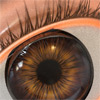- Thu Aug 10, 2006 4:33 am
#177047
This is a very basic piece of information covering dpi and resolution.
The statement, "How do I change the dpi setting to something other than 96dpi in Maxwell so I can produce hi-res images? has appeared in this forum on a number of occasions, .....so this post is in response to that question.
Let's begin ......
If you want something at 300 dpi, ...then you have to tell the renderer to do that.
How ?
First: We determine how big? 4x6 , A3, A4 ....how big (inches/cm's etc do we want the image to be ???
Let's take A3 as an example ...that's 11.7 x 16.5in. right ? ....right.
Okay, ....we need 300 dots-per-inch in everyone of those inches !
Well, ...simple enough, .....I want it to be 11.7 inches in the one direction, ..this I know.
.....so,
11.7in x 300dpi = 3510 pixels. That means, ....in order for there to be 300 dots in every inch, ...I'll need 3510 of them. Okay, ...we have the number now ------ you would enter that into the field for Height. Done.
Next:
Now we want 16.5 inches in the width direction.
Simple:
16.5 x 300dpi = 4950 pixels. Enter that into the Width. Done.
Okay, ....big render ! No doubt and maybe not a good choice for an example. LOL. ..too late.
Moving on, ...
There you have it, .....when that render is done, ....you'll have a 11.7 x 16.5 [A3] sized render at 300 dpi! But ! You say, ....no it's not, ...if I check the properties of the image, ...it says that it's at 96dpi !
Right you are. ....keep reading.
Maxwell outputs files at 96dpi.
The photo editor says that the file is 35.56 x 51.56 at 96 dpi.
Where do these numbers come from ???
Here's the math: Remember, ....even if we change the image size or dpi(same difference) the pixels will remain constant at 4950 x3510.
This won't change if we resize the image to a postage stamp or a billboard .....still 4950 x 3510 will remain, ....but the pixels themselves will change in size and either be very very tiny or very large.
Okay, ...back to our image .....
Using what we know about the image , which is our desired dpi at(300dpi) and the pixels we have to deal with(4950 x3510) we can perform a simple calculation to see the final image size.
** Note: we can use either the height or width (pixels) because we'll assume that we want the image scaled perfectly in both directions.
Most photo editors by default will [maintain proportions] if you change one of the dimensions. Meaning, ...automatically configure the other dimension. Try it and you'll see.
Let's use the width number ... 4950 pixels.

So you can see highlighted in yellow, that indeed, ...if we change the dpi in a photo editor, ...our image has a printable size of 11.70 x 16.50 ! So, ..we weren't stuck at 96 dpi at all ....
For those of you who are thoroughly versed in the subject of resolution and dpi, ...please excuse the simple nature of this info. The intent was to only bring an introduction of dpi/resolution to those who find the subject confusing.
For those of you who seek to understand the concept fully, ....I would suggest, ..simply taking an image into any photo editor and changing the dpi and observing what happens to the size(inches/cm's/mm's) of that image. This is probably the best way to fully grasp the concept.
More elaboration on the subject can be found here:
http://www.graphicdesignforum.com/artic ... sizing.htm
http://www.luminous-landscape.com/tutor ... tion.shtml
ivox.
The statement, "How do I change the dpi setting to something other than 96dpi in Maxwell so I can produce hi-res images? has appeared in this forum on a number of occasions, .....so this post is in response to that question.
Let's begin ......
If you want something at 300 dpi, ...then you have to tell the renderer to do that.
How ?
First: We determine how big? 4x6 , A3, A4 ....how big (inches/cm's etc do we want the image to be ???
Let's take A3 as an example ...that's 11.7 x 16.5in. right ? ....right.
Okay, ....we need 300 dots-per-inch in everyone of those inches !
Well, ...simple enough, .....I want it to be 11.7 inches in the one direction, ..this I know.
.....so,
11.7in x 300dpi = 3510 pixels. That means, ....in order for there to be 300 dots in every inch, ...I'll need 3510 of them. Okay, ...we have the number now ------ you would enter that into the field for Height. Done.
Next:
Now we want 16.5 inches in the width direction.
Simple:
16.5 x 300dpi = 4950 pixels. Enter that into the Width. Done.
Okay, ....big render ! No doubt and maybe not a good choice for an example. LOL. ..too late.
Moving on, ...
There you have it, .....when that render is done, ....you'll have a 11.7 x 16.5 [A3] sized render at 300 dpi! But ! You say, ....no it's not, ...if I check the properties of the image, ...it says that it's at 96dpi !
Right you are. ....keep reading.
Maxwell outputs files at 96dpi.
The photo editor says that the file is 35.56 x 51.56 at 96 dpi.
Where do these numbers come from ???
Here's the math: Remember, ....even if we change the image size or dpi(same difference) the pixels will remain constant at 4950 x3510.
This won't change if we resize the image to a postage stamp or a billboard .....still 4950 x 3510 will remain, ....but the pixels themselves will change in size and either be very very tiny or very large.
Okay, ...back to our image .....
Using what we know about the image , which is our desired dpi at(300dpi) and the pixels we have to deal with(4950 x3510) we can perform a simple calculation to see the final image size.
** Note: we can use either the height or width (pixels) because we'll assume that we want the image scaled perfectly in both directions.
Most photo editors by default will [maintain proportions] if you change one of the dimensions. Meaning, ...automatically configure the other dimension. Try it and you'll see.
Let's use the width number ... 4950 pixels.

So you can see highlighted in yellow, that indeed, ...if we change the dpi in a photo editor, ...our image has a printable size of 11.70 x 16.50 ! So, ..we weren't stuck at 96 dpi at all ....
For those of you who are thoroughly versed in the subject of resolution and dpi, ...please excuse the simple nature of this info. The intent was to only bring an introduction of dpi/resolution to those who find the subject confusing.
For those of you who seek to understand the concept fully, ....I would suggest, ..simply taking an image into any photo editor and changing the dpi and observing what happens to the size(inches/cm's/mm's) of that image. This is probably the best way to fully grasp the concept.
More elaboration on the subject can be found here:
http://www.graphicdesignforum.com/artic ... sizing.htm
http://www.luminous-landscape.com/tutor ... tion.shtml
ivox.
Fall WinterSpringSummer



 - By Mark Bell
- By Mark Bell